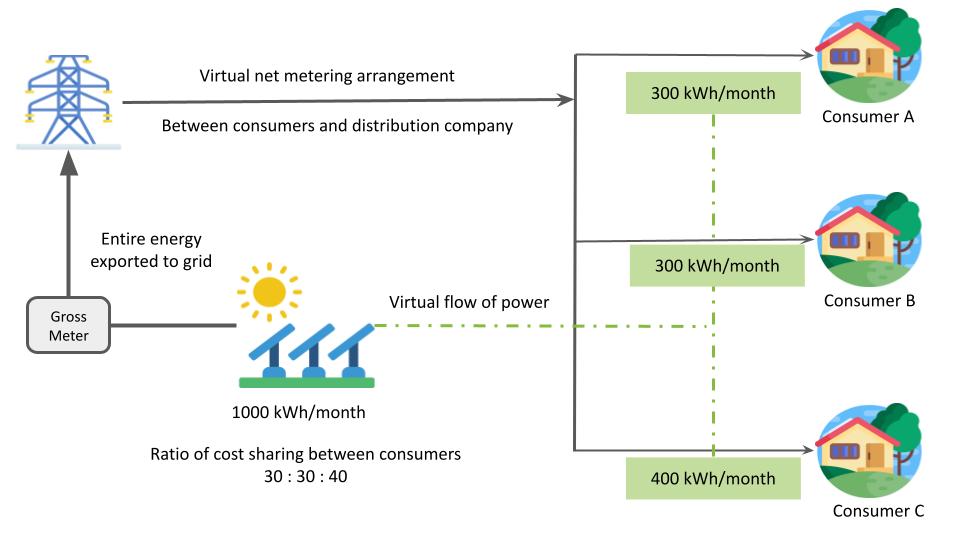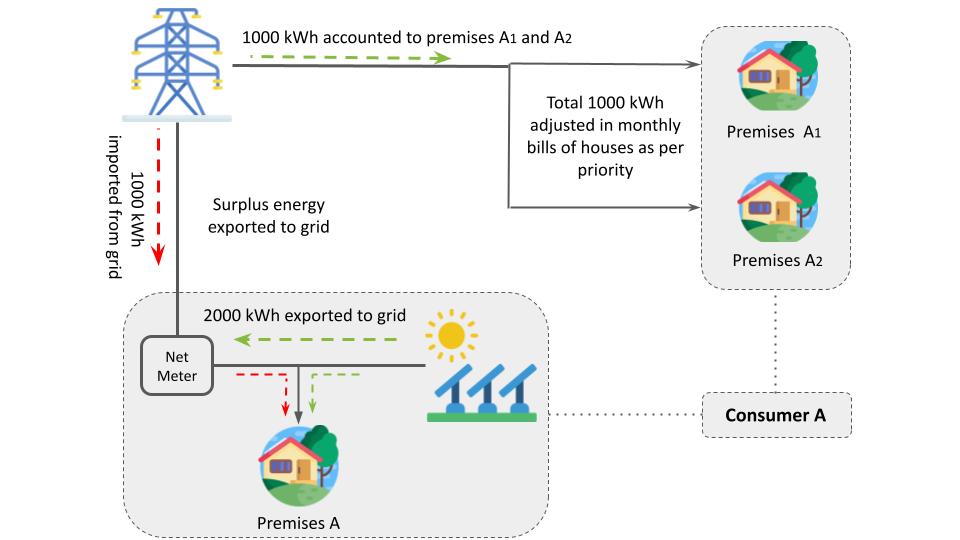Context
As of February 2024, India’s renewable energy (RE) capacity stands at ~183 GW (including hydro).1 However, distributed renewable energy (DRE), such as rooftop solar, remains under-utilised, accounting for merely ~6% 2 of the total, with utility-scale installations continuing to dominate the capacity landscape. Given the substantial room for growth in the DRE sector, emerging and innovative concepts can potentially drive the adoption of a broader range of DRE formats. Among the promising advancements in this landscape are virtual net metering (VNM) and group net metering (GNM), which encompass both rooftop and ground-mounted systems. Four state electricity regulatory commissions (SERCs) have already issued VNM and GNM regulations, with the Delhi Electricity Regulatory Commission (DERC)3 leading the way in 2019, followed by the Joint Electricity Regulatory Commission (JERC),4 the Odisha Electricity Regulatory Commission (OERC),5 and recently, the Maharashtra Electricity Regulatory Commission (MERC) in 2023. 6
What is virtual net metering?
Virtual net metering (VNM) is an arrangement that allows multiple consumers operating within the same license area to establish a collective physical RE plant. This arrangement offers two significant advantages. First, it enables consumers to benefit from economies of scale. Second, it circumvents the physical space limitations faced by individual consumers by allowing the plant to be situated independently off their premises and enjoy the advantages of net metering. The electricity generated in this arrangement is injected into the grid, and the number of units are distributed among consumers in proportion to their capital contribution to the project. Finally, each consumer can offset the allocated units against their metered consumption. If RE generation is higher than the total consumption, “netting” of the allocated units is conducted as per state metering regulations and their amendments.
Figure 1. Simple virtual net metering arrangement

Source: CEEW-CEF analysis
What is group net metering?
Group net metering (GNM) arrangements cater to a single consumer having multiple service connections across various locations within the same licensing area. It allows for the installation of RE plant at any one of these locations with land or roof availability. This arrangement offers two significant advantages. First, it enables consumers to maximise RE utilisation from a single plant. Second, similar to VNM, it circumvents the physical space limitations faced by a consumer and reap the benefits of net metering.
GNM is distinct in its approach in distributing the energy generated. The electricity generated is initially “netted” at the RE plant’s location. Any surplus electricity remaining is then distributed among other premises based on predetermined priorities. Finally, each premise’s connection can offset the allocated units against their metered consumption. If RE generation is higher than total consumption, “netting” of the allocated units is conducted as per state metering regulations and their amendments.
Figure 2. Simple group net metering arrangement
Source: CEEW-CEF analysis
Who Should Care
- Potential solar rooftop consumers
- Distribution companies (DISCOMs)
- Rooftop solar project developers
References
- [1] CEA. 2024. “All India Installed Capacity of Power Stations”. Centre Electricity Authority. https://cea.nic.in/wp-content/uploads/installed/2024/02/IC_Feb_2024allocation_wise.pdf
- [2] MNRE. 2024. “State-wise Installed Capacity of Renewable Power as on 31.03.2024”. Ministry of New and Renewable Energy. https://cdnbbsr.s3waas.gov.in/s3716e1b8c6cd17b771da77391355749f3/uploads/2024/04/202404091117551894.pdf
- [3] DERC. 2019. Group Net Metering and Virtual Net Metering for Renewable Energy Guidelines, 2019. Delhi Electricity Regulatory Commission. https://www.derc.gov.in/sites/default/files/DERC%28Group%20Net%20Metering%20and%20Virtual%20Net%20Metering%20for%20Renewable%20Energy%29%20Guidelines%2C%202019.pdf
- [4] JERC. 2019. Solar PV Grid Interactive System Based on Net Metering Regulations, 2019. Joint Electricity Regulatory Commission.
- [5] OERC. 2022. “Amendment to the Order on Net Metering/Bi-Directional Metering & Their Connectivity with Respect to Solar PV Projects 2016”. Odisha Electricity Regulatory Commission. https://www.orierc.org/CuteSoft_Client/writereaddata/upload/Amendment%20to%20Order%20on%20Net%20Metering.pdf
- [6] MERC. 2023. Grid Interactive Rooftop Renewable Energy Generating System (1st Amendment) Regulations. Maharashtra Electricity Regulatory Commission. https://merc.gov.in/wp-content/uploads/2023/11/First-Amendment-to-MERC-Grid-Interactive-RRE-Regulations.pdf



